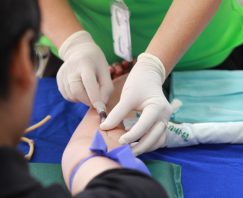Navigating the Skin Care Labyrinth
March 26, 2021 - 0 COMMENTS

Most consumers give little thought to the recognized allergens, probable carcinogens, hormone disrupters and synthetic industrial chemicals that have been inadequately tested and yet, can be found in the formulae of our skin and body care products, shampoos, conditioners, cosmetics, perfumes, infant body care products, etc. These products line the shelves of high-end department stores, drug stores, specialty retailers, and natural health retailers. With media reports warning of the toxic soup most of us bathe in daily, the ugly side of the cosmetic and personal care industry is on the radar of consumer groups such as The Breast Cancer Fund, Think Before You Pink, Environmental Working Group, The Campaign for Safe Cosmetics, as well as concerned physicians and scientists.
The public believes that the industry is regulated by a federal agency that insures toxic chemicals are not added to the products we use many times daily. So, you might wonder, who is responsible for regulating the personal care industry and looking out for consumer health and safety? The cosmetic industry will direct you to the Food and Drug Administration (FDA), the FDA will direct your query to the Cosmetics Ingredient Review (CIR) panel, and the CIR will share all the wonderful research they are conducting in the name of safety for the consumer. The problem with this picture is the CIR panel is funded by the giant mainstream personal care products companies whose ingredients and products must pass their review prior to entering the marketplace. These well recognized companies continue to use known or suspected toxic ingredients in their product formulae.
Of the FDA’s $800 million annual budget, less than 1% is allocated toward regulating the cosmetic industry. Neither the FDA nor any other government regulatory body actively assesses the safety of cosmetics before they are placed in the marketplace.
Testing for Safety?
According to Darin Stechman, Clinique’s brand representative, “Product safety has always been a top priority at Clinique Laboratories, and is ensured through state-of-the-art testing methods.” However, this testing, according to Stechman, does not include tests that establish long-term toxicity potential, carcinogenic properties, systemic absorption properties or chronic effects of daily use. Instead, large, mainstream cosmetics companies focus their research and both human and animal trial tests on assessing pre-marketed products for only allergenic reactions and skin irritations. Beyond skin eruptions and rashes, emerging science suggests that untold numbers of cosmetics and personal care ingredients may be silently and insidiously promoting cancer, disrupting women’s reproductive functions and causing birth defects.
According to Susan Roll of the Massachusetts Breast Cancer Coalition, “one third of personal care products contain ingredients classified as possible human carcinogens.” Hence, chemicals such as acrylamide (in foundation, face lotion and hand cream) linked to mammary tumors in lab research; formaldehyde (nail polish and blush) classified as a possible human carcinogen by the Environmental Protection Agency; and dibutyl phthalate (industrial chemical commonly found in perfume and hair spray) known to damage the liver, kidney and reproductive systems, disrupt hormonal processes and increase breast cancer risk, are widely used by mainstream skin care and cosmetics manufacturers. Known by hundreds of long, intimidating chemical names, these ingredients are in the products we use in our daily personal care rituals.
It’s the daily grooming ritual that is of greatest concern. These toxic ingredients are absorbed by our skin and into our bodies. The cumulative exposure to a myriad of personal care products containing carcinogens, mutagens and reproductive toxins has not been assessed.
The Ugly Side to Pretty
Many believe that by purchasing products marketed as “natural” and “organic” from health stores, high-end department stores and other specialty retailers, they are guaranteed toxin-free ingredients. Unfortunately, major loopholes in federal law allow the $35 billion cosmetics industry to police itself, allowing unlimited amounts of toxic chemicals into personal care products with no required testing, no monitoring of health effects and inadequate labeling requirements.
According to Janet Nudelman, coordinator for the Campaign for Safe Cosmetics, “The U.S. government, in relation to the FDA, has not been on the side of consumers and has not been on the side of public health.” This is obvious since cosmetic industry representatives serve on government panels that are looking into the consumer safety issue they are supposed to be regulating.
How to make Healthy Choices.
Since the CIR is funded by the well known cosmetic manufacturers and the FDA allocates so little funding toward regulating the cosmetics industry, how can the consumer confidently make healthy choices when purchasing personal care products?
Since 2000 The Environmental Working Group (EWG), a team of scientists, engineers, policy experts and lawyers, have dedicated countless hours examining data, scientific studies, and performed their own laboratory tests to expose threats to your health and the environment, and to offer solutions. Their web site, www.ewg.org provides practical information you can use to protect yourself and your loved ones.
The EWG analyzed the health and safety reviews of 10,000 ingredients in personal care products. They discovered that there is very little research available to document the safety or health risks of low dose repeated exposures to the chemical mixtures in these products. According to the EWG, the absence of this data should not be mistaken for proof of safety. The more these low dose chemical exposures are studied, the more is understood that they can cause adverse effects.
Based on their findings, the EWG has developed Skin Deep www.ewg.org/reports/skindeep, a sophisticated online rating system that ranks brand name products on their potential health risks and the absence of basic safety evaluations.
Janet Nudelman, of The Safe Cosmetics Campaign, says she uses Skin Deep regularly to look up ingredients in personal care products to find the safety reading. Her decision to purchase a product is based on the results.
In recent years, organic and 100% pure and natural products have become available from such companies as suki’s, Farmaesthetics, GratefulBody, Affusion, Monave, Earth’s Beauty, Simply Organic, WildeWood Naturals, Munchskins and more.
The health and safety of you and your loved ones is your responsibility. Read the labels of personal care products closely. If there are ingredients that you are not certain about, write them down and do a quick search to insure they are safe for use by you and your loved ones.
References:
Breast Cancer Action www.bcaction.org
Breast Cancer Fund www.breastcancerfund.org
The Make-up Labyrinth. Shauna Dineen, E The Environment Magazine, November-December 2005
Environmental Working Group www.ewg.org
www.ewg.org/reports/skindeep
Safe Cosmetics www.safecosmetics.org











